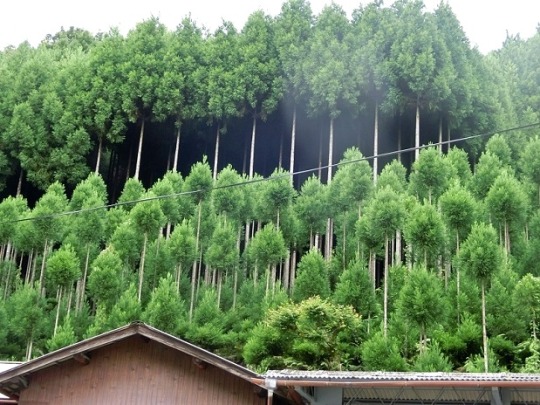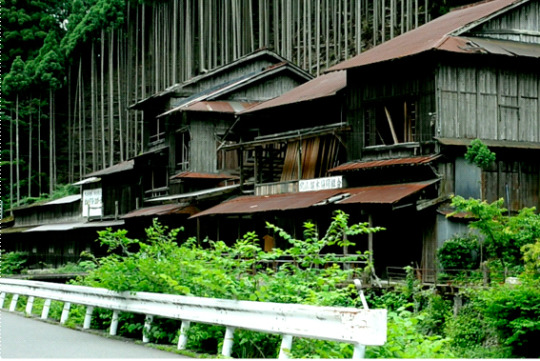#Kitayama Cedar
Photo

The Kitayama Daisugi and Cedar garden scenery at the Shozan Resort in Kita Ward, Kyoto City.
#Hanashōbu#Heian Shrine#Japan#Japanese gardens#Kitayama Cedar#Kitayama Daisugi#Kyoto#Shozan#Shozan garden#しょうざん 峰玉亭#ハナショウブ#台杉#花菖蒲
22 notes
·
View notes
Text
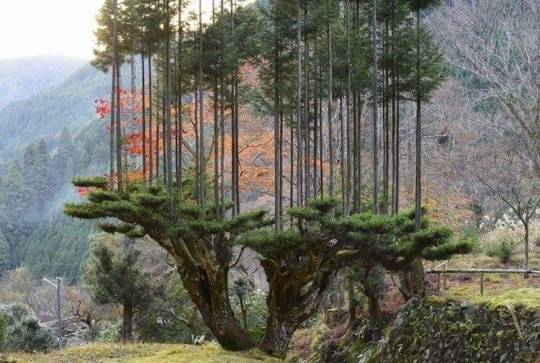
"Kitayama cedar in Japan is a tall, straight tree that is carefully cultivated so it's without knots. Foresters use a technique developed in the 15th century to help them get even more lumber. Called daisugi, it calls for one tree to be pruned like a bonsai so multiple offshoots can be harvested." Text by Jessica Stewart for My Modern Met.
119 notes
·
View notes
Photo

The Japanese have been producing wood for 700 years without cutting down trees. In the 14th century, the extraordinary daisugi technique was born in Japan. Indeed, the daisugi provide that these trees will be planted for future generations and not be cut down but pruned as if they were giant bonsai trees; by applying this technique to cedars, the wood that can be obtained is uniform, straight and without knots, practically perfect for construction. A pruning as a rule of art that allows the tree to grow and germinate while using its wood, without ever cutting it down.The technique helped to produce lumber that’s way more dense than that of a regular sugi
Japan is an intriguing country (especially for an outsider) that never ceases to amaze and inspire people by striving for perfection. It appears that the pursuit of excellence is something that’s deeply embedded in the culture, and it shows in different areas of life and various ways.
The majority of us are already familiar with the concept of bonsai—a Japanese art form dating back over a thousand years, which produces small trees that mimic the appearance of full-size trees. But many still haven’t heard about daisugi. While its technique has similarities to that of bonsai, the result it produces is vastly different.
Apparently, this technique that dates back to the 14th century was news to a lot of people. Having received more than 17k likes on Twitter, the post written by the user Wrath Of Gnon went viral on other social media platforms as well, including Imgur and Reddit. Originally invented by the people of the region of Kitayama, the method was used to solve the problem of shortage of seedlings. There is little flat land in the region, and planting and raising trees on the steep slopes proved extremely difficult. As a result, daisugi tailoring allowed arborists to reduce the number of plantations, make the harvest cycle faster, and produce denser wood as well.
Over the years, the popularity of such tree tailoring has declined. Today, these types of cedar mostly grow in well-kept gardens because of their slender and elegant appearancehttps://www.youtube.com/channel/UC1P0Ba0F_DwYTom947IvB8winstgram ı: https://www.instagram.com/anatolianleo
23 notes
·
View notes
Link
Daisugi is an ancient Japanese forestry technique in which planted cedars are pruned in a special way to produce "shoots" that eventually become perfect, straight, knot-free lumber.
This is an ancient method, developed in the 14th century, which was originally used by people living in the Kitayama region of Japan because saplings were lacking.
The terrain in the region is very mountainous, and the steep slopes make planting and caring for trees very difficult, so arborists used the daisugi technique not only to reduce the number of plantations but also to produce denser wood in a much shorter time.
7 notes
·
View notes
Text
"Daisugi - The Ancient Art Of Lumber Harvesting"

Daisugi is an ancient forest management technique that emerged in 14th or 15th century in Kyoto. The term roughly translates to "platform cedar". It inovlves selectively pruning the branches of a knotless kind of cedar known as Kitayama, which took it's name from the Kyoto region.
Cutting the side branches promotes the growth of straight, vertical shoots from a bushy base that looks like a platform. This method of lumber harvesting allows for the felling of only the upper portions of the trees, leaving the mother trunk and root system intact. Done right, the technique can prevent deforestation and result in perfectly round and straight timber known as taruki. Because the upper shots of Kitayama cedar can be harvested every 20 years, much sooner than with other methods, the technique gained popularity. Also, the lumber produced in this method is 140% as flexible as standard cedar and 200% as dense/strong, making it absolutely perfect for rafters and roof timber. It's typhoon-resistant, slender, and it's marveled at around the world 600 years later.
Although daisugi is now primarily used in gardens and bonsai, it was originally developed to address a shortage of seedling, as well as land on which to properly cultivate the trees in the first place, as the Kitayama region of Kyoto is full of hills, which made growing plants and trees extremely difficult.
Additionally, a form of very sraight and stylized sukiya-zakuri architecture, consistently focusing on usage of raw, simple materials like taruki, was considered high fashion. Such logs were used in the roofs and columns of Japanese teahouses. A rising demand for the impeccably straight and knot free taruki lumber has emerged, as the practice of tea drinking dynamically gathered more attention and sympathy from the Japanese.
Looking at this form of quite a non-invasive art creates a feeling of looking at two different kinds of trees submerged together into one, as if they are living in symbiosis, or maybe a parasitic relationship. Compared to the straight branches of this cedar, the natural, untouched base looks even chaotic. It's mesmerizing to experience the duality and contrast in such a form. I am continuously amazed by the craftsmanship, mindfulness, strategy and the companionship with nature, that the Japanese prove to imply into their solutions and techniques.
source:
https://www.openculture.com/2020/10/daisugi.html
https://www.thisiscolossal.com/2020/10/daisugi-trees-japan/
https://welum.com/article/harvest-of-wood-without-cutting-down-trees/
#trees and forests#essay#growth#mindfood#abstract#thoughts#mindful#trees#japanese#daisugi#lumberjack#nature#article#knowledge#interesting#ecology#forest#peace#just writing things
1 note
·
View note
Photo




Kitayama cedar
219 notes
·
View notes
Photo

"Kitayama cedar in Japan is a tall, straight tree that is carefully cultivated so it's without knots. Foresters use a technique developed in the 15th century to help them get even more lumber. Called daisugi, it calls for one tree to be pruned like a bonsai so multiple offshoots can be harvested." Text by Jessica Stewart for My Modern Met.
157 notes
·
View notes
Photo


Daisugi Trees
Real-life sustainability that looks like something out of a fantasy film.
“This Japanese Forestry Technique Prunes Upper Branches to Create a Tree Platform for More Sustainable Harvests
Literally translating to "platform cedar", "daisugi" is a 14th- or 15th-century technique that offers an efficient, sustainable, and visually stunning approach to forestry. The method originated in Kyoto and involves pruning the branches of Kitayama cedar so that the remaining shoots grow straight upward from a platform. Rather than harvesting the entire tree for lumber, loggers can fell just the upper portions, leaving the base and root structure intact.
Although daisugi mostly is used in gardens or bonsai today, it originally was developed to combat a seedling shortage when the demand for taruki, a type of impeccably straight and knot-free lumber, was high. Because the upper shoots of Kitayama cedar can be felled every 20 years, which is far sooner than with other methods, the technique grew in popularity.”
(from thisiscolossal.com)
272 notes
·
View notes
Photo

Daisugi, The Ancient Bonsai Technique That Can Prevent Deforestation
The practice of forestry in Kitayama is uniquely sustainable. Since the cedar trees need to be harvested by cutting down the trees wholly, the foresters have prepared the replacement for those felled trees long before they harvest the old trees.
Traditionally, it needs the foresters to wait for two generations before being able to enjoy the trees that they planted. Most of the time, it is a multi-generation plant that the foresters harvest what their grandfathers planted, and plant for their grandchildren.
To make it simpler, here is the explanation: the grandfather of forester A planted cedars to be harvested by forester A’s generation. The father of forester A doesn’t do anything to the trees because he has another slot planted by his own grandfather.
Later, when they plan on harvesting their trees, both of them plant new seedlings for their grandchildren’s generation. The father plants for forester A’s children, while forester A plants for his grandchildren. Such process continues to take place since 14th century.
It shows how advanced Kitayama people’s forestry. They have prepared their grandchildren’s share of trees before even cutting down their own share. Such practice prevents deforestation in Kitayama, and keeps the nature healthy.
(via Daisugi, The Ancient Bonsai Technique That Can Prevent Deforestation)
97 notes
·
View notes
Text
The Japanese Sustainable Forestry Technique Called Daisugi (Platform Cedar)
Daisugi is a sustainable forestry technique that originated in Kyoto in the 14th or 15th century. The tops of Kitayama cedar trees are carefully pruned so that a stand of very straight branches grow straight up from a main platform. From Spoon & Tamago:
The technique was developed in Kyoto as a means of solving a seedling shortage and was used to create a sustainable harvest of timber from a single tree. Done right, the technique can prevent deforestation and result in perfectly round and straight timber known as taruki, which are used in the roofs of Japanese teahouses.
The technique is not really used in forestry anymore, but daisugi are popular as garden trees and bonsai. There are lots of terrible videos about daisugi on YouTube, so I'd recommend watching this one from NHK about how Kitayama cedars are pruned & harvested, what the wood is used for, and a short segment on daisugi near the end.
2 notes
·
View notes
Photo

The Kitayama Daisugi and Cedar garden scenery at the Shozan Resort in Kita Ward, Kyoto City.
#Hanashōbu#Heian Shrine#Japan#Japanese gardens#Kitayama Cedar#Kitayama Daisugi#Kyoto#Shozan#Shozan garden#しょうざん 峰玉亭#ハナショウブ#台杉#花菖蒲
10 notes
·
View notes
Text
Daisugi is a centuries-old forestry technique developed in Japan as a way of cultivating the highly-prized Kitayama Cedar without actually using any land. Today, the visually-striking technique can be witnessed in ornamental gardens.
Dating back to the 14th century, daisugi allowed for the cultivation of Kitayama cedar, a species of tree known for growing exceptionally straight and lacking knots, in a time when high demand and lack of straight land for planting enough trees made growing Kitayama cedars impossible. Similar to the famous art of bonsai, daisugi basically involved heavily pruning a so-called “mother cedar tree” so that only the straightest shoots are allowed to grow. Careful hand-pruning is conducted every couple years, leaving only the top boughs and ensuring that the shoots remain knot free. After about 20 years, the now massive shoots can either be harvested as exceptional Kitayama lumber, or replanted to repopulate forests.
Not far outside of Kyoto, there are immense cedar forests planted along the hills. This Kitayama cedar is known for being exceptionally straight and without knots and has been in high demand since the 15th century. With such a demand and lack of space, foresters came up with an ingenious way to grow more wood using less land. This involves the heavy pruning of a mother cedar tree, which encourages tall, thin saplings to shoot upwards. Think of it as a bonsai on a large scale.
This technique, which is called daisugi, enables foresters to harvest wood much more quickly. The shoots can either be planted (to help quickly populate a forest) or harvested. Similar techniques can be found dating back to ancient Rome, which was called pollarding, and across Europe—particularly in Britain—where it's called coppicing. The result is slender cedar that is both flexible and dense, making it the perfect choice for traditional wood roofs and beams. Daisugi cedar can be harvested every 20 years and with the base tree lasting hundreds of years, there's a lot of wood to be harvested from just one tree.
While 20 years may seem like a long time, this is actually accelerated compared to traditional Kitayama cedar. In order to keep the trees knot-free, workers climb the long trunks every three to four years and carefully prune any developing branches.
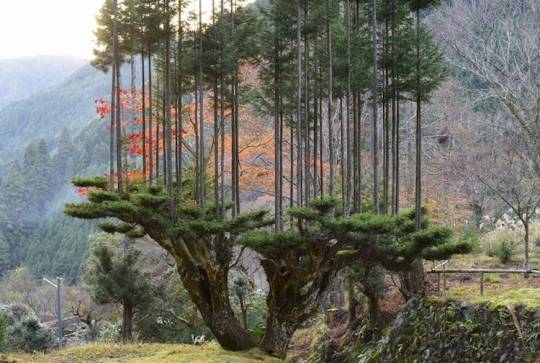
1 note
·
View note
Photo

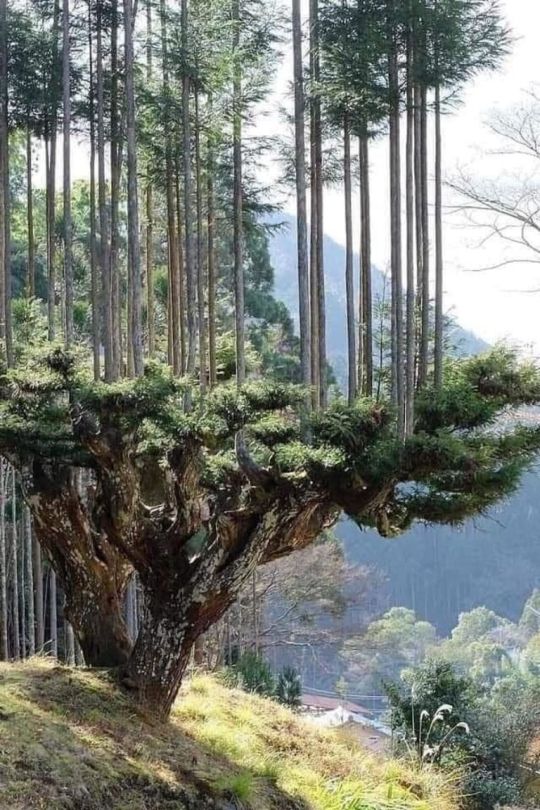

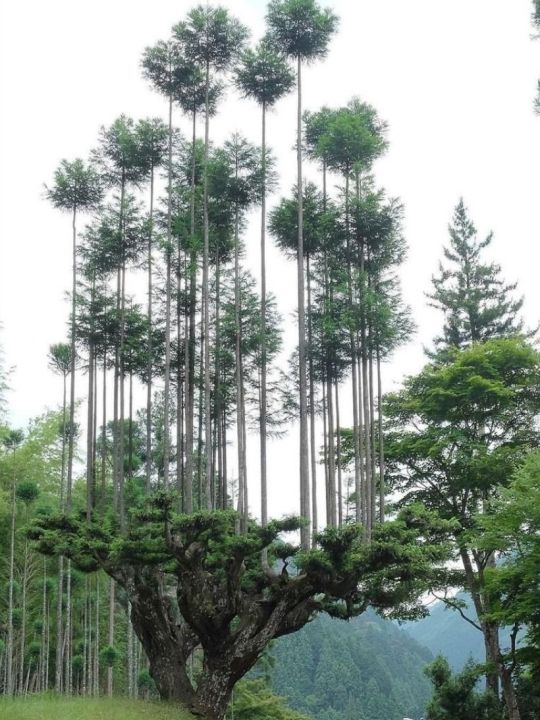
Daisugi, a Japanese coppicing technique of growing trees out of other trees - allows for harvesting lumber without having to deforest, but has also carried over to strategies of gardening aesthetics.
Daisugi (台杉) is a Japanese technique similar to coppicing, used on Cryptomeria (Sugi) trees. The term roughly translates to "platform cedar".[1]
Shoots from the base of the tree are pruned so that the trunk stays straight.[2] It is believed that the production of logs by daisugi began in the Muromachi period. At that time, the tea ceremony became popular in part because daisugi logs were used in tea room construction, for example for the tokonoma alcove. The Kitayama area of Kyoto became especially known for its forestry of daisugi.[3][4]
This technique results in a harvest of straight logs without having to cut down the entire tree.[2] Although originally a forestry management technique, daisugi has also found its way into Japanese gardens.[5]
1 note
·
View note
